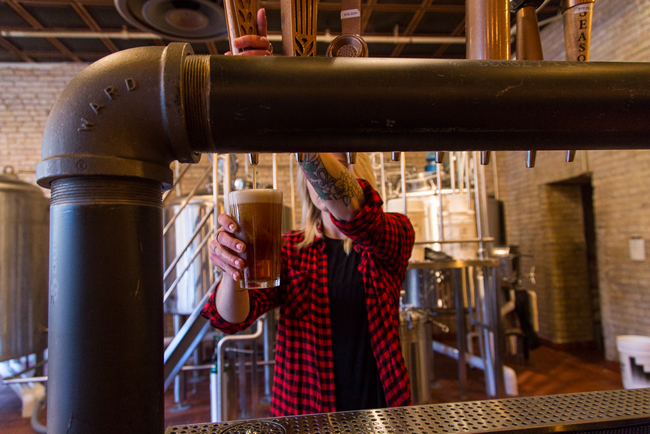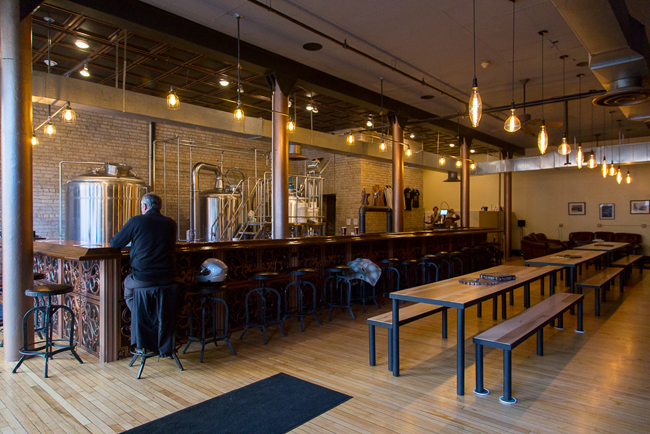
This week in the Toast: barrel-aged beers from Insight Brewing, a review of Clockwerks in the Warehouse District of Minneapolis, and a taste of Skaalvenn Habanero Rum.

Gravity Well Release
Insight Brewing is celebrating its second anniversary this week with the release of Gravity Well, an imperial stout aged in scotch and bourbon barrels.
The beer has been aging for a year in all, first in stainless steel tanks and since August in wooden barrels. Unlike last year, when the final bottled product was a blend of beer aged in bourbon and rye whiskey barrels, this one will not be blended after aging. This means that drinkers will get to choose between scotch- and bourbon-finished bottles, each possessing their own character.

The science of the partnership between beer and wood is by no means exact, which we appreciated as we sampled from multiple Scotch barrels. Sips from the first barrel were boozy and hot, with an unexpected dark-chocolate backdrop. A mild slickness punctuated each sip, yet the beer was not heavy. The second Scotch barrel, on the other hand, delivered a potent acetone aroma with a more rounded flavor. The robust roasted malt of the stout paired equally as well with bourbon barrels, this time creating a sweeter profile that highlighted the espresso and warming nature of the beer.

Barreling will continue to expand at Insight as the current head brewer, Ryan Mihm, and owner-brewer Ilan Klages-Mundt both have experience barreling — Mihm at Colorado’s New Belgium Brewing Company and Maine’s Allagash Brewing Company, and Klages-Mundt in London, among other places. Aging beer in barrels isn’t as simple as just filling them up. The barrels must be properly prepped and stored, and each batch must be tasted frequently to find the peak wood character.
Bottles will be released this Saturday at the brewery along with other surprises.

Clockwerks Brewing Now Open
As Minneapolis’ Warehouse District witnesses major construction in adjacent neighborhoods — the North Loop and Downtown East are currently booming with crane activity — long-vacant spaces are feeling more and more out of place. Clockwerks Brewing, which opened about a month and a half ago on Fourth Street, near First Avenue N, has filled one of those spaces, although it stands among still-vacant storefronts to its north and east.
Clockwerks stands out as a brewclub amid a nightclub scene, and it stands out from the pack of new breweries around the Twin Cities, as well, because it is only a brewpub with no distribution planned. The beer will be sold only across the bar in pints and growlers. And though Clockwerks is a brewpub, it doesn’t have a full kitchen, but it will have bar snacks and charcuterie in the future.

Owners Lonnie Manresa and Brett Michlitsch have been longtime home brewers and haven’t lost sight of their roots; the array of seven tap lines will always feature one home-brewer’s recipe. During our visits, the home brewer was Manresa’s father.
As for the house beers, there is no real focus in terms of style. Available taps include Belgian, Czech, German, and British beers. The Belgian witbier was true to style, with classic clove and citrus notes, but it suffered from fermentation flaws including a corny finish that increased with even the slightest warming. This may be indicative of a process issue, such as not allowing the wort to boil long enough. Ultimately, those new to the style may find it okay, but lovers of Belgian beer will find the sweet finish distracting.
Less successful was the ESB, or Extra Special Bitter, a classic among U.K. styles that is not totally unfamiliar to Minnesota craft-beer drinkers due to U.K.-influenced breweries like Summit and Northgate. The medium-brown beer was brilliantly clear, but immediately, the wort-like aroma signaled that something went wrong. The taste, too, was troubling with its syrupy flavor of beer before fermentation, as though the yeast were interrupted mid-meal. Due to the sweetness, the glass lacked flavor and complexity, especially in the hop department. It was especially disappointing given the success of the Alt, another medium-bodied, moderately hoppy style.

The clear winner of the list is the Alt. Altbier is a German hybrid style of beer — it combines elements of lager and ale — not often seen in American taprooms. This version is at the high end of bitterness for the style, with a pleasant and balanced toasted malt character that is not sweet or roasty. Although the Alt will appeal to pale ale drinkers, it will be the favorite among those who tend towards the wide “amber” department.
Improved since our first visit was the Bohemian Rye Pilsner. On first sip, the overwhelming wet-newspaper taste was indicative of the beer’s being exposed to oxygen, and the beer was not appealing. The second try, though, revealed improvements in the recipe or the technique: The bright and crisp finish, hallmarks of a successful Pilsner, met understated rye and cereal notes. A pleasant Saaz hop finish was prominent but not too grassy or bitter.

Clockwerks is located in a cozy spot previously occupied by City Billiards, and the current owners have kept one refurbished pool table as entertainment as well as to serve as a throwback to the old tenants. The remaining decor is so uncoordinated and unfinished that it is hard to look at. Along one wall are beautiful antique botanical posters, while the few booths along another wall have exposed staples and nails. Despite the heavy use of the self-proclaimed term “steampunk,” only a few underperforming elements are to be seen: an art installment made of metal cogs, re-used and mismatched tap handles, and goggles around one bartender’s neck. Steampunk is a commitment and Clockwerks has not followed through. During our visit, the smattering of attempts felt bland to some and gimmicky to others.

Skaalvenn Habanero Rum
In an unexpected divergence from its emphasis on classic spirits — vodka, rum, and aquavit — Skaalvenn released a habanero rum this month that brings a new meaning to winter warmer. For those perennially campaigning against the too-sweet warm spice, creamy, or peppermint cocktails of the fall and winter, arm yourselves with this rum, made with fresh habanero and Thai peppers.
At first glance, a spicy rum may seem too specialized for the home bar. It is spicy, to the point where drinking it straight requires ice, at the very least. But after a few sips, it proved to be a favorite, and after the palate acclimates to the heat, the taste profile is remarkable with well-defined habanero flavor rather than simple heat. The peppers are not smoky or vegetal.
What’s more, the spirit itself has taken some of the work out of mixology, offering complexity in a bloody mary or unexpected heat when combined with tropical fruit or honey. An enjoyable tempered heat is in evidence when the rum is combined with a curaçao or a sweeter tonic like Blue Henn. Distiller Tyson Schnitker has always been vocal in his desire to create mixable spirits rather than ultra-premium bottles, and the Habanero Rum is evidence of that.
